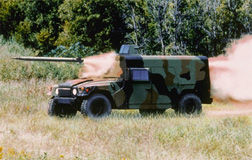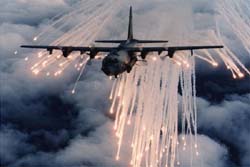Daily News
by Gail Helmer
[ Send Us News | Archives ]
Panzer Campaign Patches Released
HPS Simulations has released patch updates for Panzer Campaigns, Smolensk ' 41, Normandy '44 and Kharkov '42. For full details click here.
Military News
Lockheed Martin Receives First Contract for LOSAT Production Missiles
Lockheed Martin has received a contract for the first production lot of tactical Line-of-Sight Antitank (LOSAT) Weapon System missiles. The $9.3 million contract represents the first production run of the extremely powerful Kinetic Energy Missile (KEM), which is fired from the LOSAT vehicle.
"This is our first contract for tactical LOSAT missiles," said Darrell McBrayer, LOSAT program director for Lockheed Martin. "LOSAT has been in development for many years, and it's quite satisfying to finally see steps taken to ensure the deployment of the system to the soldier. These 108 missiles will be used to equip the first tactical LOSAT unit, A Company of the 5-11th Parachute Infantry Regiment."
McBrayer said these missiles would ensure a heavy anti-armor, go-to-war capability where it is most needed - with early-entry forces. "The Army's transformation forces will now have the most devastating anti-armor system in the world at their disposal. LOSAT delivers overwhelming lethality to any target it engages. The high mobility of the system combined with unstoppable power of the missiles makes it the perfect anti-armor system for our early-entry forces."

LOSAT consists of kinetic energy missiles and a second-generation FLIR/video acquisition sensor mounted on an air-mobile, up-armored HMMWV chassis. LOSAT will help alleviate the forced-entry/early-entry force lethality shortfall against heavy armor because it can deploy with both forces. LOSAT provides a high volume of extremely lethal and accurate missile fire that is effective against heavy armor systems at distances that exceed current ranges of main gun tanks.
Key advantages of LOSAT include the tremendous overmatch lethality of the KEM, which defeats all projected future armored combat vehicles, and its ease of deployability. The LOSAT weapon system also provides increased survivability for the operator and improved countermeasure effectiveness. It operates to the maximum range of direct-fire combat engagements, and provides dramatically increased rates of fire and enhanced performance under day and night, adverse weather and obscured battlefield conditions.
The Kinetic Energy Missile weighs 174 pounds, is 113 inches long and 6.4 inches in diameter. The current system provides for a three-man crew, but a crew of two can also conduct engagements.
The LOSAT equipped Expanded Capacity HMMWV has a combat weight of approximately 12,000 pounds. The system has an effective range of several miles and is "near fire and forget." With a missile speed of 5,000 feet per second, it reaches maximum range in less than five seconds. The LOSAT missile is a hit-to-kill missile with no explosive warhead. It carries a long-rod penetrator and destroys the target through the application of brute force. Each HMMWV chassis mounts four missile launch pods. The system can be reloaded in less than 10 minutes using on-board materiel handling equipment.
Northrop Grumman to Equip C-130s with LAIRCM
Northrop Grumman Corporation's Electronic Systems sector has been awarded a contract to equip U.S. Air Force Air Mobility Command C-130 aircraft with infrared countermeasures systems designed to protect such aircraft from the threat of heat-seeking missiles.
The $12.9 million contract is for the engineering and manufacturing development of Northrop Grumman's Large Aircraft Infrared Countermeasures (LAIRCM) system for eventual installation on the C-130 aircraft. The two-year contract will include production options for the installation of the system onto seven aircraft.

This latest modification follows a $66 million contract the Air Force awarded Northrop Grumman in September 2001 for the engineering and manufacturing development phase of a laser-based IRCM system for the C-17 and C-130 transport aircraft. There are production options for the initial contract that equal approximately $105 million.
"Work on the LAIRCM program for the Air Force has been progressing well and is on schedule," said Bob Del Boca, director, IRCM and Laser Systems for Northrop Grumman's Defensive Systems Division. "The addition of LAIRCM will provide these C-130 aircraft with the ability to rapidly and accurately detect and defeat hostile infrared missiles, including increasingly common surface-to-air missiles."
LAIRCM is a laser-based variation of Northrop Grumman's lamp-based Directional Infrared Countermeasures (DIRCM) system, Nemesis, which is currently in use by the military in both the United States and the United Kingdom.
Additionally, installation of Northrop Grumman DIRCM systems is progressing on U.S. Special Operations Command (USSOCOM) aircraft. During the past year, DIRCM systems have been installed on four "kit-proofed" aircraft (MC-130H, MC-130E, AC-130H, and AC-130U), and ground and flight testing have been completed on the range at Eglin Air Force Base, Fla. In 1999, USSOCOM awarded Northrop Grumman a contract modification to produce and install DIRCM systems on 59 Special Operations C-130 aircraft.
[ Send Us News | Archives ]
by Gail Helmer
Monday August 12, 2002
- Panzer Campaign Patches Released
- Lockheed Martin Receives First Contract for LOSAT Production Missiles
- Northrop Grumman to Equip C-130s with LAIRCM
Panzer Campaign Patches Released
HPS Simulations has released patch updates for Panzer Campaigns, Smolensk ' 41, Normandy '44 and Kharkov '42. For full details click here.
Military News
Lockheed Martin Receives First Contract for LOSAT Production Missiles
Lockheed Martin has received a contract for the first production lot of tactical Line-of-Sight Antitank (LOSAT) Weapon System missiles. The $9.3 million contract represents the first production run of the extremely powerful Kinetic Energy Missile (KEM), which is fired from the LOSAT vehicle.
"This is our first contract for tactical LOSAT missiles," said Darrell McBrayer, LOSAT program director for Lockheed Martin. "LOSAT has been in development for many years, and it's quite satisfying to finally see steps taken to ensure the deployment of the system to the soldier. These 108 missiles will be used to equip the first tactical LOSAT unit, A Company of the 5-11th Parachute Infantry Regiment."
McBrayer said these missiles would ensure a heavy anti-armor, go-to-war capability where it is most needed - with early-entry forces. "The Army's transformation forces will now have the most devastating anti-armor system in the world at their disposal. LOSAT delivers overwhelming lethality to any target it engages. The high mobility of the system combined with unstoppable power of the missiles makes it the perfect anti-armor system for our early-entry forces."

LOSAT consists of kinetic energy missiles and a second-generation FLIR/video acquisition sensor mounted on an air-mobile, up-armored HMMWV chassis. LOSAT will help alleviate the forced-entry/early-entry force lethality shortfall against heavy armor because it can deploy with both forces. LOSAT provides a high volume of extremely lethal and accurate missile fire that is effective against heavy armor systems at distances that exceed current ranges of main gun tanks.
Key advantages of LOSAT include the tremendous overmatch lethality of the KEM, which defeats all projected future armored combat vehicles, and its ease of deployability. The LOSAT weapon system also provides increased survivability for the operator and improved countermeasure effectiveness. It operates to the maximum range of direct-fire combat engagements, and provides dramatically increased rates of fire and enhanced performance under day and night, adverse weather and obscured battlefield conditions.
The Kinetic Energy Missile weighs 174 pounds, is 113 inches long and 6.4 inches in diameter. The current system provides for a three-man crew, but a crew of two can also conduct engagements.
The LOSAT equipped Expanded Capacity HMMWV has a combat weight of approximately 12,000 pounds. The system has an effective range of several miles and is "near fire and forget." With a missile speed of 5,000 feet per second, it reaches maximum range in less than five seconds. The LOSAT missile is a hit-to-kill missile with no explosive warhead. It carries a long-rod penetrator and destroys the target through the application of brute force. Each HMMWV chassis mounts four missile launch pods. The system can be reloaded in less than 10 minutes using on-board materiel handling equipment.
Northrop Grumman to Equip C-130s with LAIRCM
Northrop Grumman Corporation's Electronic Systems sector has been awarded a contract to equip U.S. Air Force Air Mobility Command C-130 aircraft with infrared countermeasures systems designed to protect such aircraft from the threat of heat-seeking missiles.
The $12.9 million contract is for the engineering and manufacturing development of Northrop Grumman's Large Aircraft Infrared Countermeasures (LAIRCM) system for eventual installation on the C-130 aircraft. The two-year contract will include production options for the installation of the system onto seven aircraft.

This latest modification follows a $66 million contract the Air Force awarded Northrop Grumman in September 2001 for the engineering and manufacturing development phase of a laser-based IRCM system for the C-17 and C-130 transport aircraft. There are production options for the initial contract that equal approximately $105 million.
"Work on the LAIRCM program for the Air Force has been progressing well and is on schedule," said Bob Del Boca, director, IRCM and Laser Systems for Northrop Grumman's Defensive Systems Division. "The addition of LAIRCM will provide these C-130 aircraft with the ability to rapidly and accurately detect and defeat hostile infrared missiles, including increasingly common surface-to-air missiles."
LAIRCM is a laser-based variation of Northrop Grumman's lamp-based Directional Infrared Countermeasures (DIRCM) system, Nemesis, which is currently in use by the military in both the United States and the United Kingdom.
Additionally, installation of Northrop Grumman DIRCM systems is progressing on U.S. Special Operations Command (USSOCOM) aircraft. During the past year, DIRCM systems have been installed on four "kit-proofed" aircraft (MC-130H, MC-130E, AC-130H, and AC-130U), and ground and flight testing have been completed on the range at Eglin Air Force Base, Fla. In 1999, USSOCOM awarded Northrop Grumman a contract modification to produce and install DIRCM systems on 59 Special Operations C-130 aircraft.
